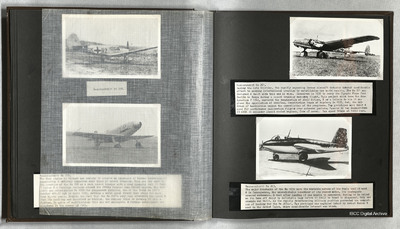Messerschmitt Me 261 and Me 263
Title
Messerschmitt Me 261 and Me 263
Description
Photo 1 is a port side view of a Me 261.
Photo 2 is a port side view of a Me 263.
Photo 2 is a port side view of a Me 263.
Coverage
Language
Type
Format
Two b/w photographs on an album page
Publisher
Rights
This content is available under a CC BY-NC 4.0 International license (Creative Commons Attribution-NonCommercial 4.0). It has been published ‘as is’ and may contain inaccuracies or culturally inappropriate references that do not necessarily reflect the official policy or position of the University of Lincoln or the International Bomber Command Centre. For more information, visit https://creativecommons.org/licenses/by-nc/4.0/ and https://ibccdigitalarchive.lincoln.ac.uk/omeka/legal.
Identifier
PThomasAF20080012
Transcription
[Photograph]
Messerschmitt Me 261.
During the late thirties, the rapidly expanding German aircraft industry devoted considerable effort to gaining international prestige by establishing new world records. The Me 261 was designed & built with this end in view. Conceived in 1937 to carry the Olympic Flame from Berlin to Tokyo during a record breaking non-stop flight. This project which bore the designation P 1064, captured the imagination of Adolf Hitler, & as a tribute to him it was given the appellation of Adolfine. Construction began at Augsburg in 1939, but, the outbreak of hostilities caused the cancellation of the programme. Two prototypes were built & used for performance calibration flights over extended periods. Powered by two Daimler-Benz DB 610A 24 cylinder liquid cooled engines. Crew of seven. Max speed 385mph at 10000 feet.
[Photograph]
Messerschmitt Me 263.
The major drawbacks of the Me 163b were the unstable nature of the fuels that it used & in Consequence, the unpredictable behaviour of its rocket motor, its inadequate powered endurance, & that after landing it was unable to manoeuvre, having to be raised on its take off dolly by inflatable bags before it could be towed to dispersal. Only one example was built, as the rapidly deteriorating military position prevented the completion of tooling for the Me 263A-1. The prototype was captured intact by Soviet Forces & sent to the Soviet Union, where considerable interest was shown.
Messerschmitt Me 261.
During the late thirties, the rapidly expanding German aircraft industry devoted considerable effort to gaining international prestige by establishing new world records. The Me 261 was designed & built with this end in view. Conceived in 1937 to carry the Olympic Flame from Berlin to Tokyo during a record breaking non-stop flight. This project which bore the designation P 1064, captured the imagination of Adolf Hitler, & as a tribute to him it was given the appellation of Adolfine. Construction began at Augsburg in 1939, but, the outbreak of hostilities caused the cancellation of the programme. Two prototypes were built & used for performance calibration flights over extended periods. Powered by two Daimler-Benz DB 610A 24 cylinder liquid cooled engines. Crew of seven. Max speed 385mph at 10000 feet.
[Photograph]
Messerschmitt Me 263.
The major drawbacks of the Me 163b were the unstable nature of the fuels that it used & in Consequence, the unpredictable behaviour of its rocket motor, its inadequate powered endurance, & that after landing it was unable to manoeuvre, having to be raised on its take off dolly by inflatable bags before it could be towed to dispersal. Only one example was built, as the rapidly deteriorating military position prevented the completion of tooling for the Me 263A-1. The prototype was captured intact by Soviet Forces & sent to the Soviet Union, where considerable interest was shown.
Collection
Citation
“Messerschmitt Me 261 and Me 263,” IBCC Digital Archive, accessed November 5, 2024, https://ibccdigitalarchive.lincoln.ac.uk/omeka/collections/document/23277.
Item Relations
This item has no relations.

